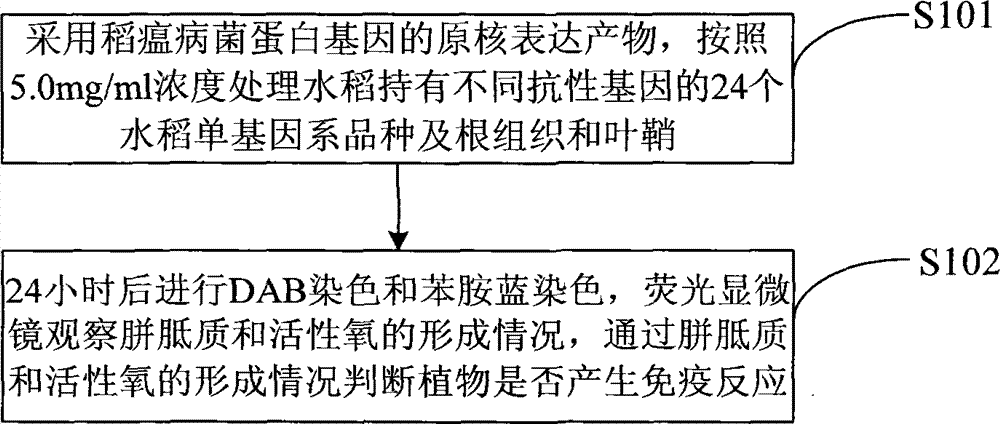Method for detecting generation of plant immunoreaction
An immune response, plant technology, applied in material excitation analysis, fluorescence/phosphorescence, etc., can solve the problems of poor practicability, complex process, low accuracy, etc., and achieve the effect of strong promotion and application value
- Summary
- Abstract
- Description
- Claims
- Application Information
AI Technical Summary
Problems solved by technology
Method used
Image
Examples
Embodiment 1
[0020] 5.0 mg / ml fusion protein was used to treat rice root tissue and leaf sheath for 24 hours, and the callose was directly observed after aniline blue staining and the generation of active oxygen was observed by DAB staining.
[0021] Centrifuge the expression product of the effector protein gene of Magnaporthe grisea to collect the cells, and suspend the cells with freshly prepared buffer solution (20mM Tris-HCl, pH7.4; 200mM NaCl; ImM EDTA; 10mM β-mercaptoethanol) . The supernatant was collected by centrifugation after ultrasonography to disrupt the cells in an ice-water bath. The treatment is to purify the prokaryotic expression product of the gene and treat the root tissues and leaf sheaths of 24 rice monogenic lines with different resistance genes at a concentration of 5.0 mg / ml for 24 hours, and observe the callose after direct staining with aniline blue and DAB staining and active oxygen generation. The results are shown in the table. It was found that the 24 rice ...
Embodiment 2
[0023] 5.0 mg / ml fusion protein was used to treat rice root tissue and leaf sheath for 24 hours, and the callose was directly observed after aniline blue staining and the production of active oxygen was observed by DAB staining.
[0024] Centrifuge the expression product of the effector protein gene of Magnaporthe grisea to collect the cells, and suspend the cells with freshly prepared buffer (20mM Tris-HCl, pH7.4; 200mM NaCl; 1mM EDTA; 10mM β-mercaptoethanol) . The supernatant was collected by centrifugation after ultrasonography to disrupt the cells in an ice-water bath. The treatment is to treat the root tissue and leaf sheath of the susceptible rice variety at a concentration of 5.0 mg / ml after purification of the prokaryotic expression product of the gene for 24 hours, and observe the production of callose and active oxygen after aniline blue direct staining and DAB staining. The results are shown in the table. It was found that the susceptible rice variety Lijiang Xintu...
PUM
 Login to View More
Login to View More Abstract
Description
Claims
Application Information
 Login to View More
Login to View More - R&D
- Intellectual Property
- Life Sciences
- Materials
- Tech Scout
- Unparalleled Data Quality
- Higher Quality Content
- 60% Fewer Hallucinations
Browse by: Latest US Patents, China's latest patents, Technical Efficacy Thesaurus, Application Domain, Technology Topic, Popular Technical Reports.
© 2025 PatSnap. All rights reserved.Legal|Privacy policy|Modern Slavery Act Transparency Statement|Sitemap|About US| Contact US: help@patsnap.com

